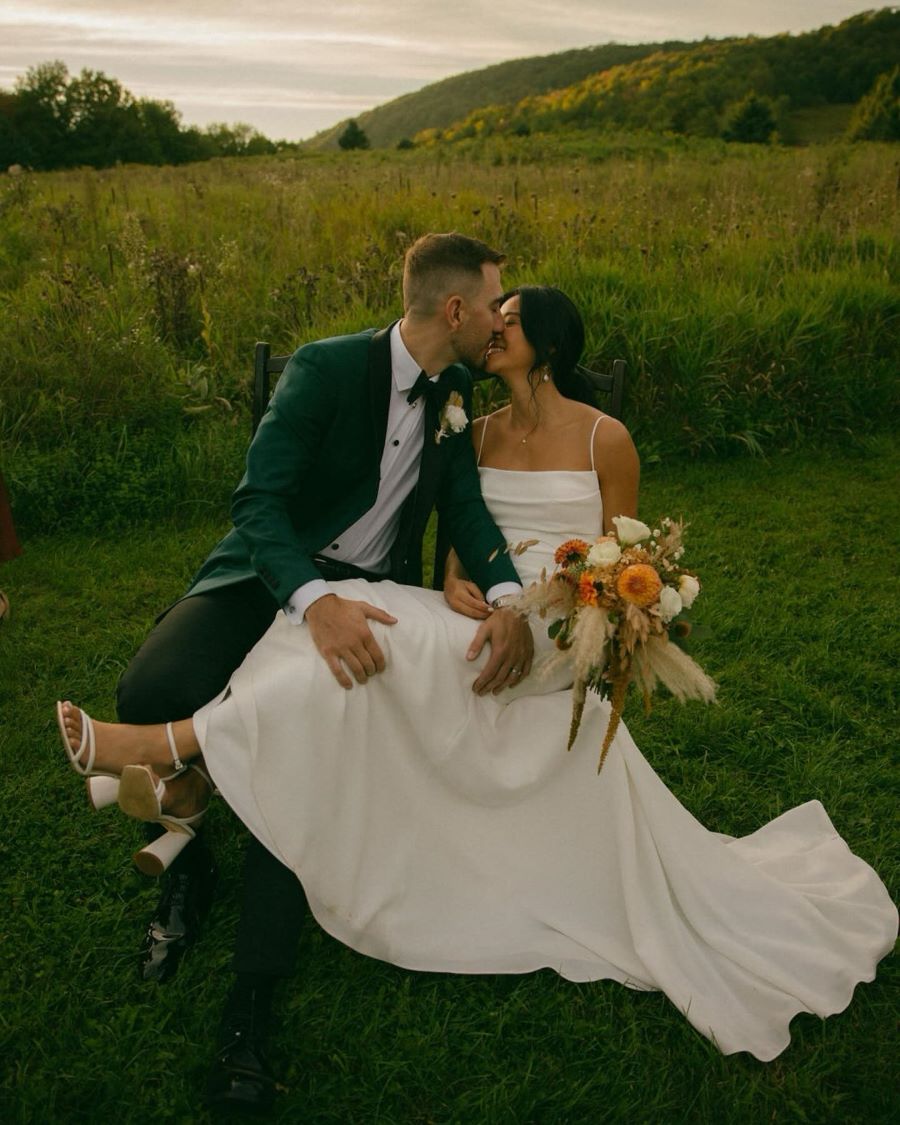Whether you’re dreaming up your own wedding ceremony from scratch or using the traditional ceremony format of your house of worship, becoming familiar with the order of a typical wedding ceremony is very helpful. Most ceremonies follow a similar outline, so if you’ve attended (or been in) a couple of weddings, then you’ve probably got an idea of how things will happen.
Of course, different cultures and religions will incorporate other elements or have a specific order of events; also, you can personalize the proceedings with your own touches—songs, readings, prayers, vows you’ve written yourselves—to put a meaningful and memorable stamp on the ceremony.

Photo by Authentic Collective
What is the correct order of a wedding ceremony?
Here’s the good news: there is none! The wedding ceremony order is actually all dependent upon your beliefs and how you want to go about it. You definitely do not need to conform to preconceived notions of how a wedding ceremony should progress.
Feel free to mix it up and be adventurous, but you may want to keep the wedding officiant and wedding planner in the loop to help determine that the ceremony order fits within your wedding day timeline.
The Wedding Ceremony Outline for Your Wedding Style
Whether you’re more traditional or you’re looking for a modern twist to your ceremony, these outlines should help give you the inspiration to make your walk down the aisle one to remember.
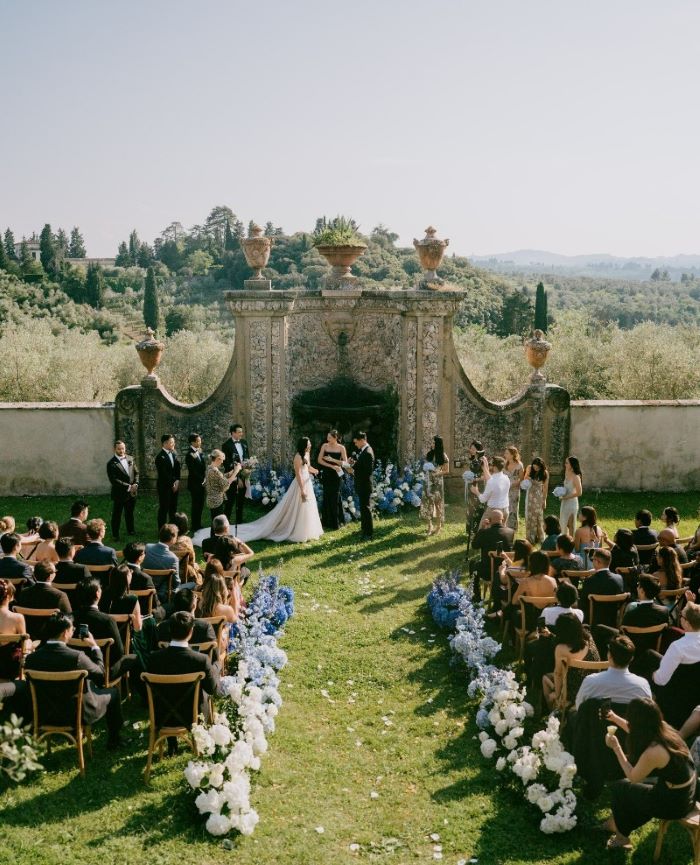
Photo by Jose Daniel
Traditional Wedding Ceremony Order
What you’ll find below is a traditional wedding ceremony order of events to serve as a framework for your own wedding ceremony–but don't feel like you need to include every step or stick to a certain time frame.
SEATING GUESTS
Ushers are responsible for welcoming the guests to their seats; this typically happens 30 to 45 minutes before the ceremony start time. Ushers should seat guests from the front rows to the back and also according to designated sides (left side of the aisle vs. right side of the aisle) if the couple has decided to do so.
This can be timed to coincide with the ceremony music start time (with live musicians or recorded music playing in the background). The exception: special guests who have been reserved seats in the front rows.
SEATING FAMILY MEMBERS
In some traditional ceremonies, the immediate family is seated as part of the beginning of the ceremony, and in this order:
- The grandparents
- The groom’s mother
- The groom’s father
- And finally, the bride’s mother
PROCESSIONAL
The entry of the wedding party is often the highlight of the traditional wedding ceremony. This is known as the processional, as the members of the wedding party walk in and take their places at the front.
You and your fiancé can each make your way down the aisle separately, with your parents, or even hand-in-hand together. For a traditional Christian procession, the bride is escorted by her father, while the groom waits up front. For a Jewish procession, the groom’s mother and father walk him down the aisle together, followed by the bride escorted by her parents.
INTRODUCTORY REMARKS
The officiant starts by welcoming the guests and wedding party for this special day. The content of the address will vary from officiant to officiant, but it usually includes what marriage stands for and how the ceremony will progress.
If you are including readings in your wedding, the officiants would introduce the close friends and family members providing those readings.
THE VOWS
The vows are the promises you make to one another. You may want to recite the traditional vows—“to have and to hold, from this day forward”—or write your own. (If you’d like to write your own, follow our tips and tricks to writing the perfect wedding vows.)
RING EXCHANGE
The ring bearer then brings up the rings and they are exchanged. Keeping with tradition, the groom puts the ring on the bride first, followed by the bride doing the same for the groom. The officiant usually guides the couple in this process.
PRONOUNCEMENT AND KISS
The officiant seals the ceremony with the declaration, “I now pronounce you husband and wife,” or “husband and husband,” or “wife and wife.” Make sure your wedding photographer is ready to capture the first kiss!
CLOSING REMARKS AND RECESSIONAL
The officiant seals the ceremony with the declaration of, “I now pronounce you husband and wife,” or “husband and husband,” or “wife and wife.” Make sure your wedding photographer is ready to capture the first kiss!
Looking for inspiration? Explore these popular wedding traditions and their origins to help you choose which elements to include in your ceremony.
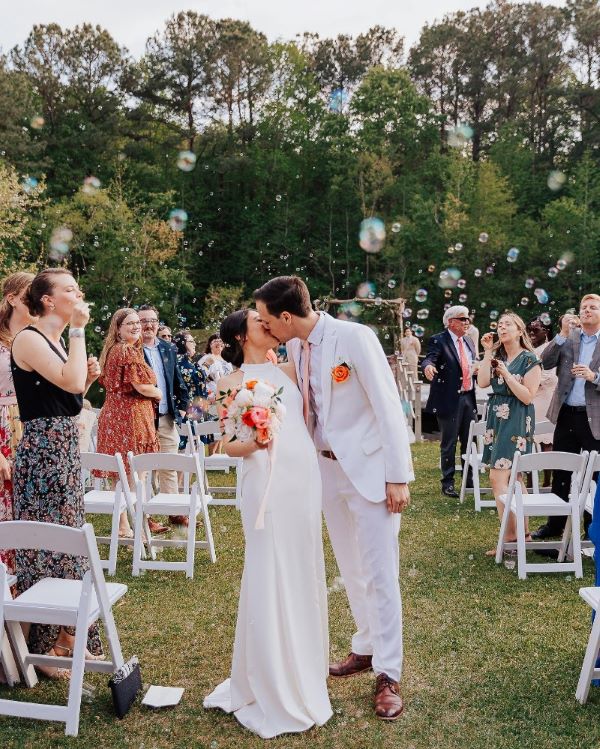
Photo by Julia W Photography
Modern Wedding Ceremony Order
In a modern wedding ceremony–it’s all about what you as a couple want to include. So please personalize this wedding ceremony order as you’d like!
SEATING GUESTS
In a modern wedding, often guests arrive and have welcome drinks before finding their seats. There are no specific sides, and people can sit where they’d like.
You might still have a special time for the family members to come down the aisle before the wedding party and bride. Instead of the father of the bride accompanying the bride, you might see both parents walking with the bride, or the couple walking down the aisle together.
INTRODUCTORY REMARKS
Like the more traditional wedding, you’ll still have an officiant begin the proceedings, most likely without religious references. They will still welcome the guests and get the ceremony underway.
VOWS
In a modern wedding ceremony order, the couple often writes their own vows and reads them from memory or written notes.
RING EXCHANGE & PRONOUNCEMENT
The officiant guides the couple in exchanging of the rings and pronounces the couple married, and that it’s time for the first kiss.
CLOSING UP
After the kiss, the newlyweds will lead their wedding party from the ceremony location and the rest of the guests will follow. The couple may then take photos while guests enjoy a cocktail hour before the reception.
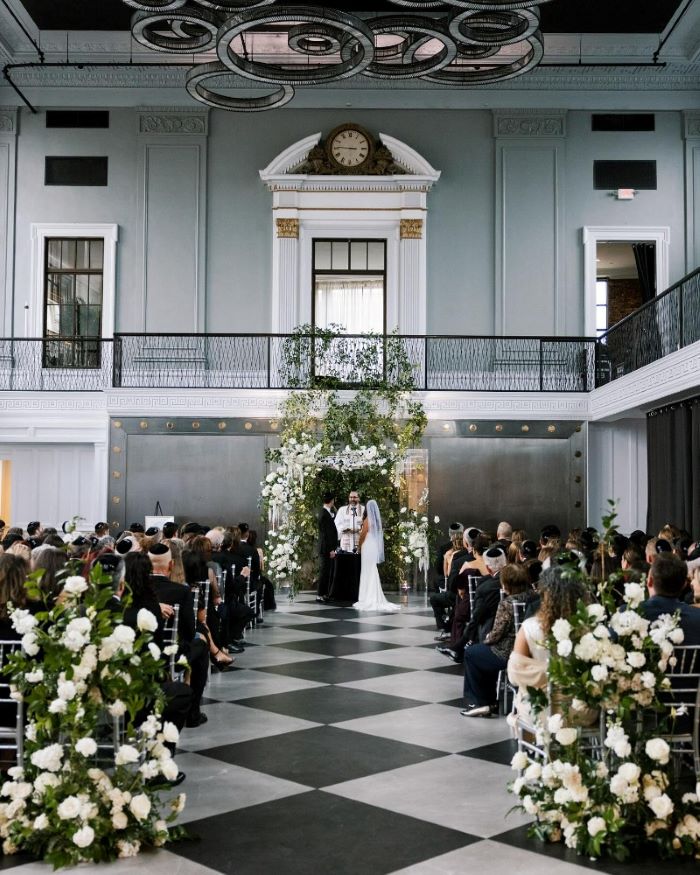
Photo by Afrik Armando
Jewish Wedding Ceremony Order
PROCESSIONAL
The rabbi leads the processional, followed by the bride and groom’s grandparents, who will sit on opposite sides of the aisle. The groomsmen enter next in tow with the best man.
The groom and his parents walk to the chuppah next. The bridesmaids move in, along with the maid of honor, the ring bearer, and the flower girl. At the end, the bride proceeds to the chuppah along with her parents.
VOWS
The chuppah is a structure that represents the new home that the newlyweds will live in. The vows take place inside the chuppah. The bride and the groom have the option of going through with this part of the ceremony with or without their parents.
CIRCLING
Once at the chuppah, hakafot, a form of ritualistic circling, commences. In the hakafot, the bride walks around the groom seven times which symbolizes a protective wall. In more modern Jewish weddings, the couples do the circling thrice each to symbolize an equal division of roles in the marriage.
EXCHANGING THE RINGS
The groom puts the ring on the bride while the ketubah, the Jewish marriage contract, is recited. Traditional ceremonies demand that the blessings and the prayers be read in Hebrew, but more modern ceremonies use English as well to accommodate non-Jewish guests.
SEVEN BLESSINGS
The seven blessings, or the sheva brachot, are chanted over the newlyweds. The officiants do the needful or you might find it prudent to choose certain immediate family members or guests to recite the blessings. After the blessings are concluded, the bride and groom drink wine from the same cup.
BREAKING OF THE GLASS
The most anticipated part of the ceremony, where the couple steps on a cloth-wrapped glass together and the guests yell out, “Mazel tov!”
RECESSIONAL
This happens at the end of the ceremony, where everyone else exits in the opposite order that they entered in, with the newlyweds leading the way.
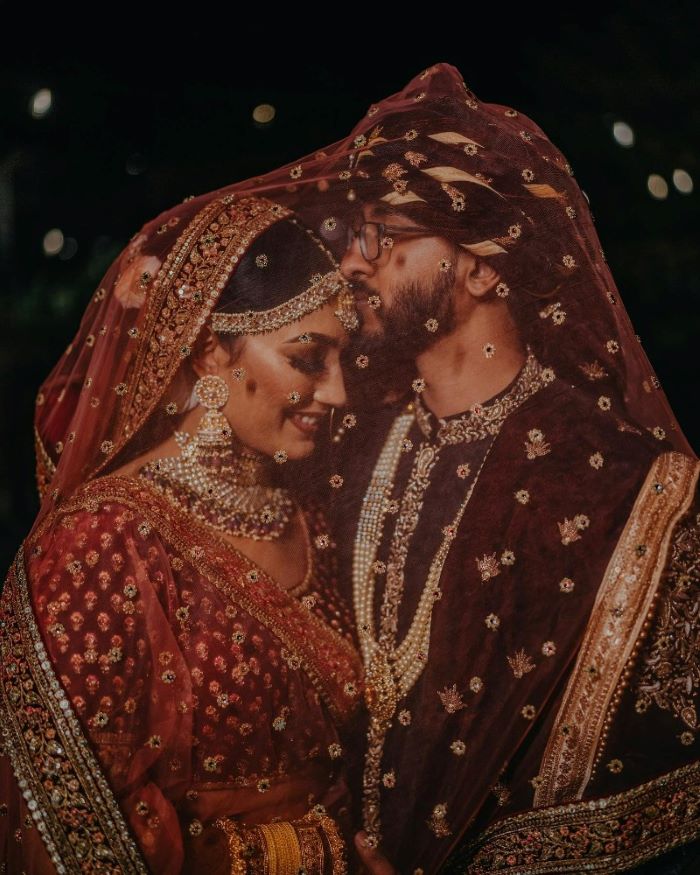
Photo by Sunnyside Weddings
Hindu Wedding Ceremony Order
THE GROOM ARRIVES
Traditionally, the bride’s family is in charge of organizing the wedding ceremony. The celebrations are kicked off when the groom arrives with his entourage, the baraat. The groom will most likely be riding a decked-out mare while all his family and loved ones dance around him to lively music.
The ceremonial ride from the groom’s house to the wedding venue is all done on foot.
MEETING THE BRIDE’S PARENTS
After arriving, the groom meets the bride’s parents and her closest confidants. Tradition dictates that he be given a good luck charm, the shagun (usually money or new clothes).
THE BRIDE ARRIVES
The bride enters, accompanied by male family members (usually uncles or brothers). They then walk to the father, who is waiting before the altar.

Photo by Amrit Photography
GIVING AWAY THE BRIDE
One of the most emotional moments of the entire wedding ceremony follows, where the father of the bride will give her away to her husband-to-be. This is a tenet of Hindu tradition, wherein the bride is not available to the groom until she has been offered to him.
GARLAND EXCHANGE
The action shifts to the mandap, or the ceremonial tent, where the bride and groom exchange garlands. The ceremony commences with the priest chanting prayers in Sanskrit.
LIGHTING THE FIRE
The sacred fire is lit with the aid of clarified butter and wood. This is done to invoke Agni, the god of fire in Hindu mythology, and to ask him to witness the union.
SEVEN REVOLUTIONS
The groom’s scarf and the edge of the bride’s saree are tied together and they walk around the sacred flame seven times. After this, they are officially married.
RICE SHOWER
This signals that the ceremony is at an end, as the bride and groom are showered with rice, saffron, and other choice items, symbolizing a prosperous married life.
BLESSING THE UNION
After the rice shower, the bride and the groom bow to the gathered crowd. Their parents bless them with tender embraces and words of advice and the happy gathering proceeds out of the wedding area.
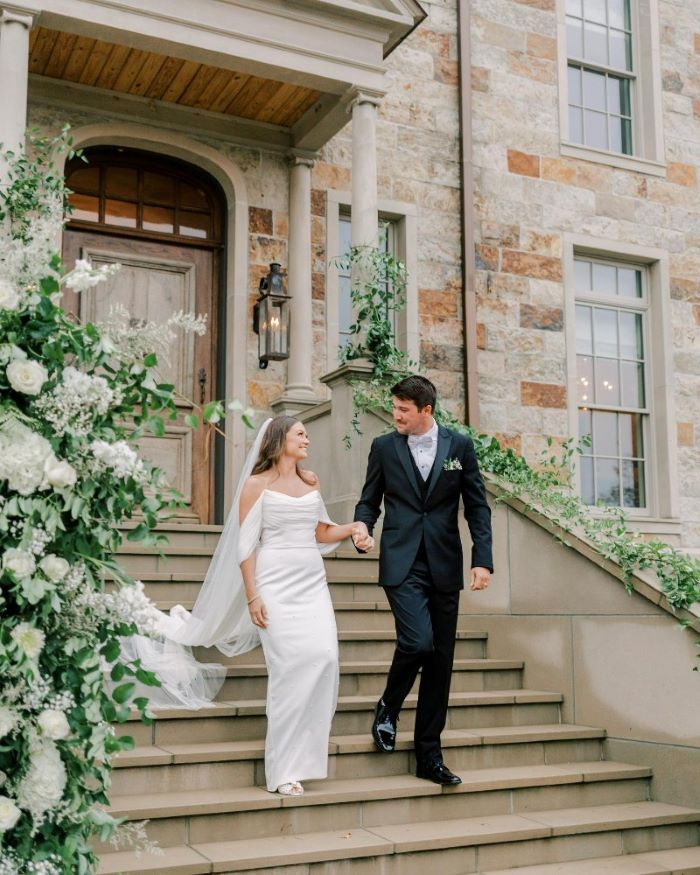
Photo by Emily Quigley Photography
Catholic Wedding Ceremony Order
A truly spiritual experience, Catholic weddings are held in a church and befit an air of solemnity and piety. A number of unique events differentiate it from traditional weddings, with ceremonies like the Liturgy of the Word, the Gospel Acclamation, the Homily, and many others.
PROCESSIONAL
The priest and the ministers walk to the altar first. Only then do the rest of the members of the processional enter, in the following order: groom, best man, groomsmen, maids of honor, bridesmaids, ring bearer, flower girl, and the bride and her father.
READINGS
In a ceremony called the Liturgy of the Word, family members or designated guests read selected passages from the Bible.
SERMON
Everyone stands as a selected Biblical passage is read by the priest, which is then interpreted by him in a sermon.
VOWS
One has to abide by the set of vows decided by the Catholic Church. The way to go here is by affirming with the effective “I do.”
EXCHANGING RINGS
One of the main events of the wedding, the priest will sprinkle some holy water over the rings and pray over them. Then the bride and the groom put the rings on each other’s fingers.
OFFERTORY
Pre-selected guests will walk down the aisle to present the pair with gifts.
LITURGY OF THE EUCHARIST
The bread and wine are symbolically transformed into the body and blood of Christ with the liturgy of the Eucharist. This is followed by the entire congregation being led into a recitation of the Lord’s Prayer.
COMMUNION
Congregation members gather to receive the Holy Eucharist. If you don’t feel comfortable doing so, you may abstain.
KISS
The priest tells the groom that he may kiss the bride and then the priest reads the nuptial blessing afterward.
RECESSIONAL
The reverse order is followed when the wedding congregation and the newlyweds walk down the aisle and out of the church, with guests throwing rice at the couple.

Photo by Amor Studios
Multicultural Wedding Ceremony Order
Just as love transcends cultural boundaries, a multicultural wedding ceremony blends cherished traditions from different backgrounds into one harmonious celebration. While every couple's cultural combination will be unique, here's a framework to help you plan your ceremony order.
PROCESSIONAL
Begin with music that represents both cultures — this could be alternating songs or even a specially arranged fusion piece. Family members enter following both cultural customs, with multiple officiants if traditional for either culture. The couple's entrance can incorporate meaningful elements from both backgrounds.
OPENING CEREMONIES
The ceremony can begin with welcomes in both languages, making all guests feel included. Traditional blessings from both cultures follow, with brief explanations of key cultural elements so all guests can fully appreciate their significance.
CORE CEREMONIES
The heart of your ceremony can include vows exchanged in multiple languages and carefully chosen unity rituals from each tradition. This might include a ring exchange or traditional gift exchange, followed by special cultural ceremonies such as a tea ceremony or handfasting ritual — whatever best represents your shared heritage.
PRONOUNCEMENT & CLOSING
The ceremony can conclude with declarations in both languages, followed by traditional closing gestures from each culture. The recessional can joyfully combine both cultural customs, creating a celebratory exit that honors both backgrounds.
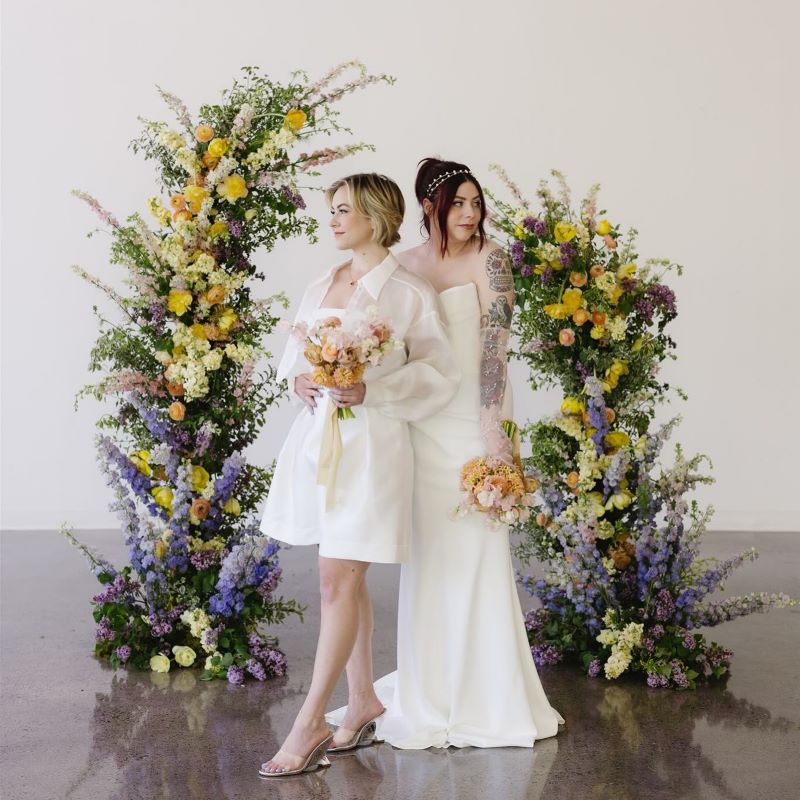
Photo by Stephanie Wolf Photo
Short & Sweet Wedding Ceremony Order
Many modern couples are opting for shorter, more intimate ceremonies while still maintaining the meaningful elements that make their day special. If you're planning a micro-wedding or intimate celebration, here's how to structure a brief but beautiful ceremony.
SEATING GUESTS
Unlike traditional ceremonies, guests can arrive and be seated informally with soft background music playing. The arrangement can be less formal with the wedding party positioned in advance to create a streamlined beginning to the ceremony.
PROCESSIONAL OPTIONS
The beauty of a shorter ceremony is the flexibility it offers in how you make your entrance. You can choose to keep some traditional elements while streamlining others, or completely reimagine how you and your loved ones enter the ceremony space. You have several choices for a simplified processional:
- The couple enters together
- A quick wedding party entrance followed by the couple
- Each partner enters separately but without formal escort
- Family members and couple enter as one group
WELCOME & INTRODUCTION
The officiant can provide a brief welcome and set the tone for the ceremony. This can take 1-2 minutes and can focus on the couple's story and the meaning of the gathering.
READINGS OR MUSIC
You can select one meaningful reading or musical selection. This keeps the ceremony moving while still incorporating personal touches that reflect your relationship.
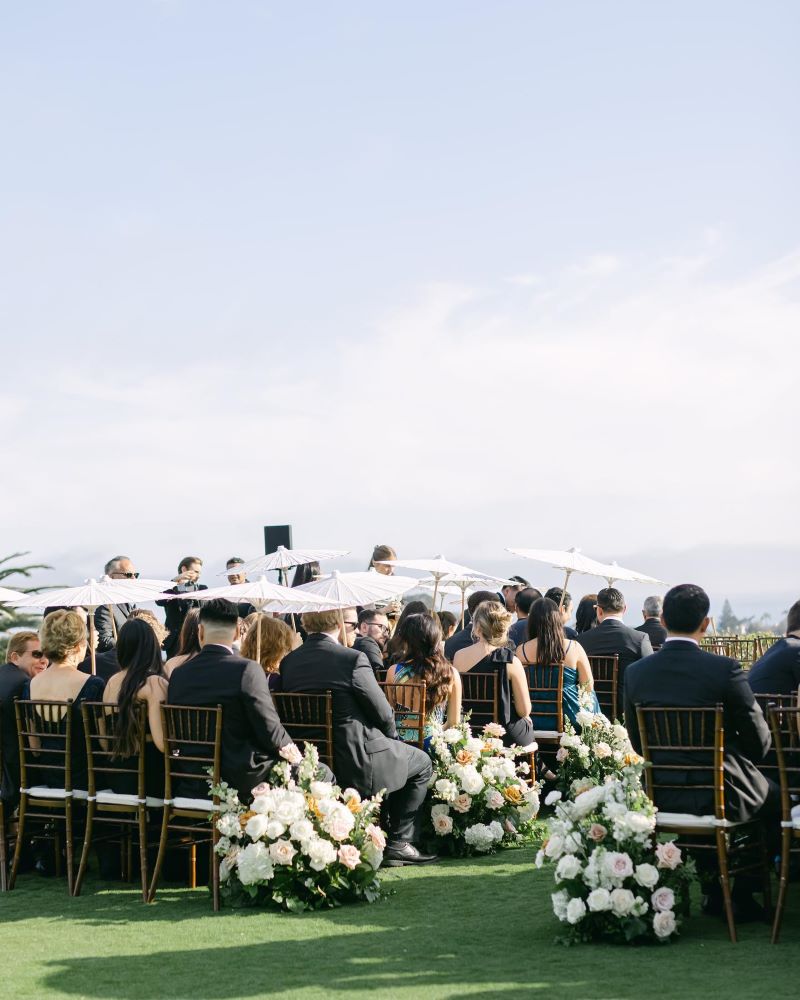
Photo by Aura Elizabeth
VOWS
Your vows can be brief and heartfelt at the same time. These can be traditional or personal but are typically kept to 1-2 minutes per person. Some couples choose to share their longer, more detailed vows privately before or after the ceremony.
RING EXCHANGE
The ring exchange will be straightforward and efficient, with the officiant guiding you through meaningful wording. You can personalize this moment by adding your own brief sentiments or incorporating family rings with special significance.
PRONOUNCEMENT & KISS
After the officiant pronounces you married, you can share your first kiss and be presented to your guests. This moment can be just as special in a shorter ceremony format.
RECESSIONAL
Make a quick, joyful exit that leads immediately into the celebration. Music should be upbeat and transitions seamless. You can choose to have guests toss flower petals, blow bubbles, or simply cheer as you make your way back down the aisle. This moment sets the perfect tone for transitioning into photos or your reception, keeping the day's momentum and energy flowing.
This condensed ceremony format typically runs 15-30 minutes total, perfect for couples who want to focus on the essential elements while moving efficiently into their celebration. Remember, a shorter ceremony can be just as meaningful as a longer one when the key moments are thoughtfully planned.
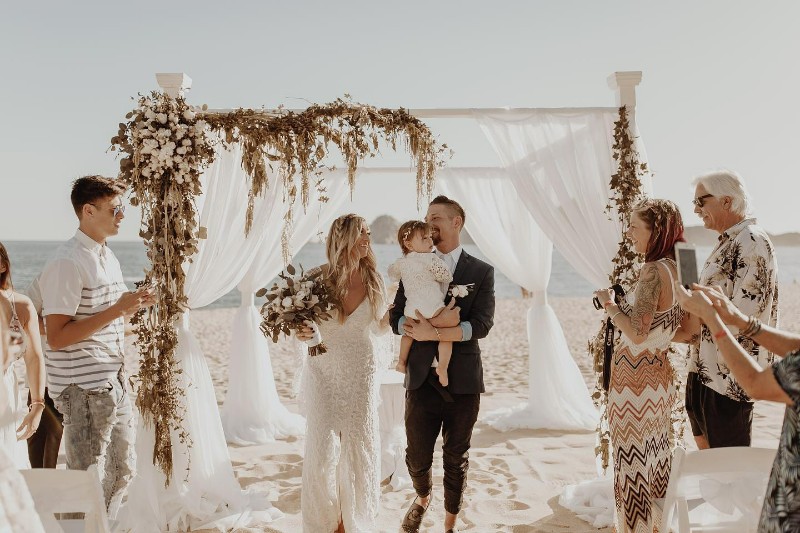
Photo by Strohm Photography
Wedding Ceremony Order for Second Weddings
It’s a blessing to get a second chance at this declaration of love, and for your second wedding ceremony, you can choose a traditional wedding outline or a more pared-down version like we have included here. Minted can be your loyal companion during this time, with a bounty of ideas for casual wedding invites and wedding orders.
PROCESSIONAL
This is not a mandatory part of wedding ceremony orders for second weddings (or really any), but it’s a good way to involve your kids and other family members in this moment of your shared happiness.
SEATING GUESTS
Unlike a first wedding, there is less pressure to maintain seat orders or sides. The guests can seat themselves and be closer to the bride and the groom as they wish.
INTRODUCTORY REMARKS
Most likely, you’ll still have an officiant involved who’ll kick off the proceedings by welcoming guests and starting the ceremony.
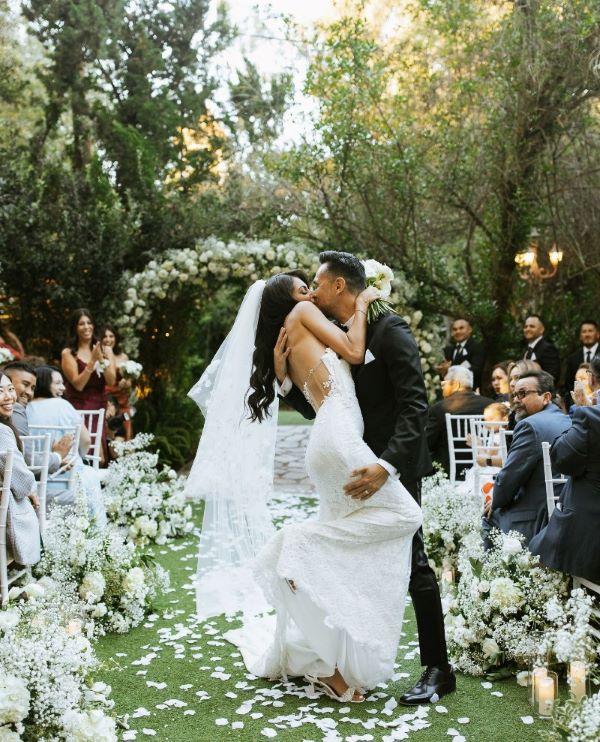
Photo by Kai Villanueva Photography
VOWS
Vows will depend on what faith you are marrying under. For a comprehensive list of vow inspiration, head here!
RING EXCHANGE & PRONOUNCEMENT
The officiant greenlights the exchanging of the rings and pronounces the couple married, as they lean in for the picture-perfect kiss.
RECESSIONAL
After the kiss, the recessional commences and everyone walks out in reverse of the order that they came in and the preparations for further festivities take place.
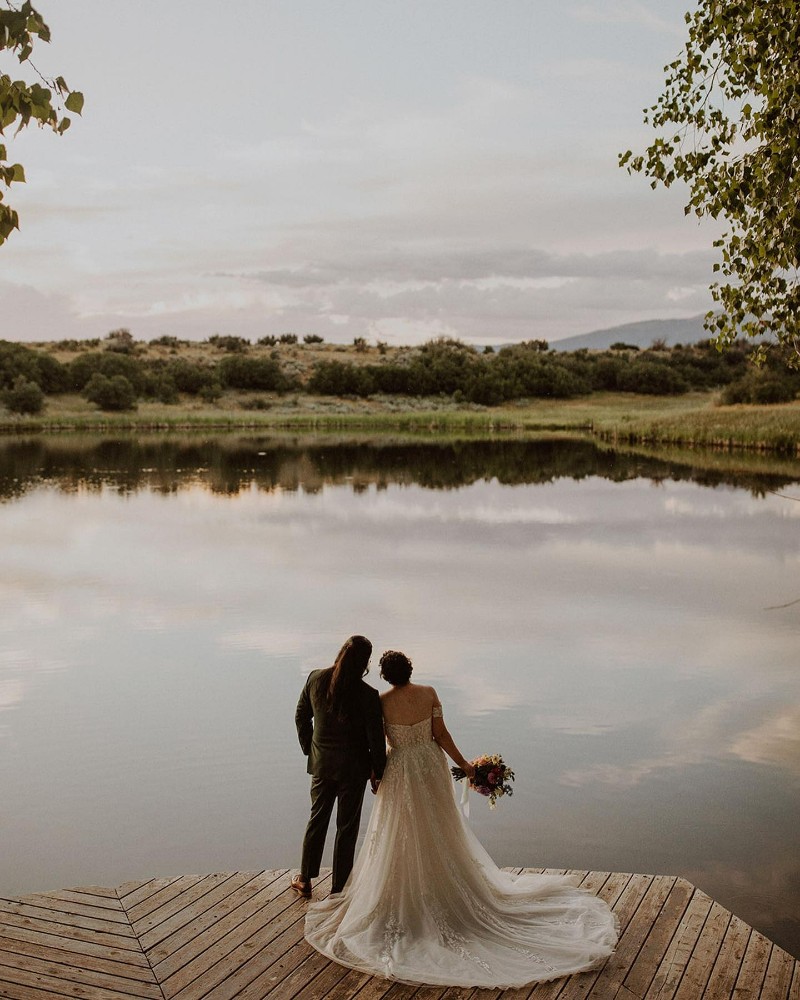
Photo by Carissa Marie Photography
Nondenominational Wedding Ceremony Order with Unity Candle
Nondenominational weddings offer a lot of flexibility with regard to the exact wedding ceremony order and, as a result, couples who want modernity in their wedding tend to opt for that. Minted has you covered with its wide selection of nondenominational wedding invitations and programs.
PROCESSIONAL
The groom leads the processional, with the best man, groomsmen, bridesmaids, maid of honor, ring bearers, flower girl, and the bride with her parents. The groom and the groomsmen can also enter from the side and wait for the wedding party to enter down the aisle. After the processional, the officiant begins the proceedings.
READING
You might wish to assign your favored persons to read prayers, favorite passages from books, poems and so much more. It’s up to you how many readings you’d want.
UNITY CANDLE RITUAL
Nondenominational ceremonies typically call for couples to light a unity candle, which, as the officiant will tell you, symbolizes unity and commitment. This is followed by a unifying ritual which can be anything that you feel is meaningful as a display of your love for each other. It can be anything from handfasting to creating a time capsule to planting a tree to meaningful quotes.
VOWS
Your vows can be entirely bespoke and you are free to express yourself as you would want to. Be sure to utter your declaration of “I do!” with the brightest smile possible.
RING EXCHANGE
The rings are put on next, a symbol of your fidelity to each other.
KISS
The kiss seals the deal. Ideal for moments that are conducive to photography. Congratulations to the newlyweds!
RECESSIONAL
The bride and the groom exit the ceremony area to spirited celebrations by the attendees.
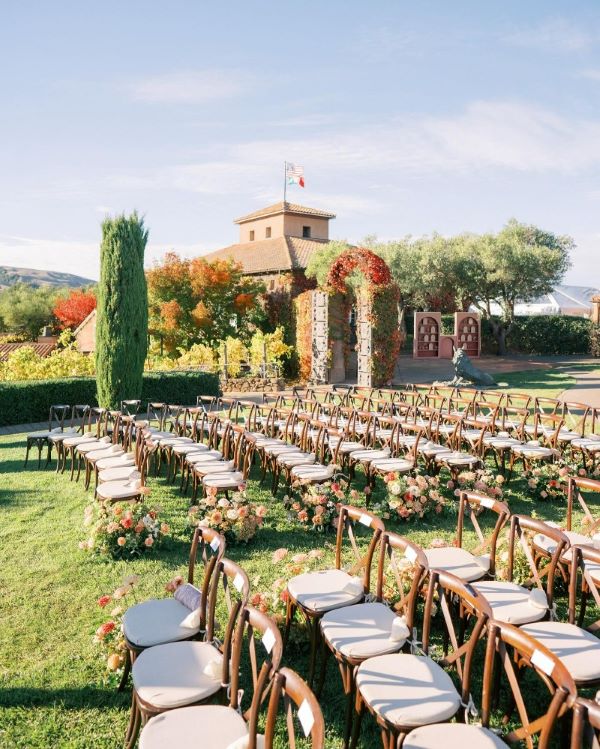
Photo by Willow and Ben Photography
Setting the Scene: Timing Your Ceremony by Location
The timing of your ceremony can greatly impact your wedding day experience. Different locations present unique considerations for scheduling and planning. Here's how to make the most of your chosen setting.
SUNSET CEREMONIES
Good timing can make a sunset ceremony really special. The light is beautiful and your photos will show it. Schedule your ceremony time by working backward from sunset, allowing 20-30 minutes for your vows.
Pro Tip: Plan for "golden hour" – that perfect lighting just before sunset. You'll want to schedule your first look and photos earlier to make the most of it.
BEACH CEREMONIES
If you're planning a beach wedding, you'll want to think about a few key timing details. Check those tide schedules first and aim for early morning or late afternoon when it's cooler. Early morning or late afternoon ceremonies often provide the most comfortable temperatures for guests. The time of year can impact sunset timing and weather conditions significantly. Plan for a concise ceremony, keeping in mind factors like wind, heat, and guest comfort on the sand.

Photo by Sofia Theresa Photo
GARDEN CEREMONIES
You'll find that gardens make stunning ceremony spots, but timing really matters here. Ask about peak blooming periods to align your ceremony timing with the garden's most vibrant displays. Morning ceremonies can take advantage of crisp, cool air and fresh blooms. Consider how trees and structures might affect natural lighting throughout the day. Your venue coordinator will know exactly when the garden looks its best.
MOUNTAIN/ADVENTURE CEREMONIES
Heading to the mountains? You'll need to think about a few extra logistics. Factor in travel time to your ceremony spot and plan for an early start when the weather's most stable. Morning ceremonies often offer clearer weather conditions in mountain settings. Keep the ceremony length comfortable for guests who may be standing or sitting in natural settings. Scout your location ahead of time to check sun position and shadows.
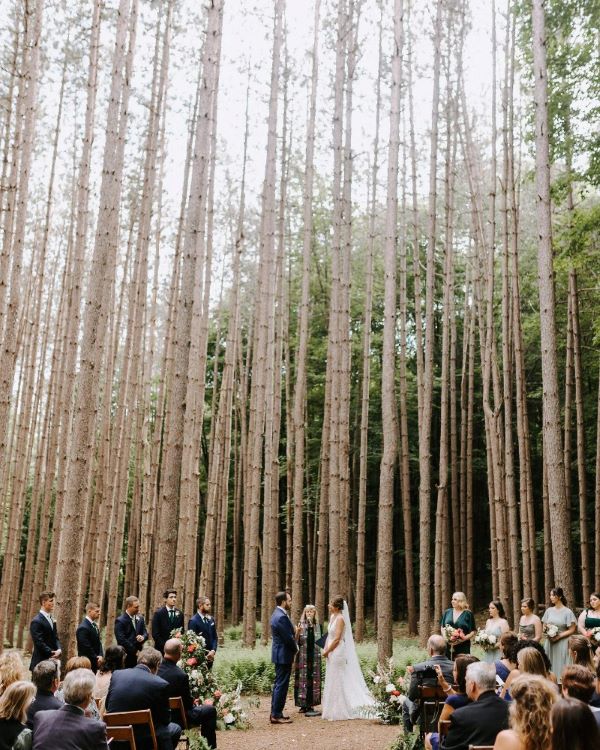
Photo by Hyde Photography
WEATHER CONSIDERATIONS
Weather is going to be a big factor in your outdoor ceremony planning. While you can't control it, knowing the weather patterns for your chosen location and season helps create a more comfortable experience while ensuring your ceremony runs smoothly.
For sunset ceremonies, schedule 30-45 minutes earlier than needed to buffer against cloud cover. Beach ceremonies work best early morning before coastal winds pick up. Garden ceremonies? Check rainfall patterns and pick your region's driest month. And for mountain ceremonies, early morning is your best bet before those afternoon storms roll in.
Regardless of your ceremony location, always have a backup plan ready. Work with your venue and planner to develop weather contingencies that maintain the atmosphere you envision while keeping your guests comfortable.
To help you plan the perfect ceremony schedule, check out our guide to creating your wedding day timeline.

Photo by Sarah Houston Photography
Wedding Ceremony Outline FAQs
It’s normal to have a bunch of questions about your wedding. Making the process effortless to understand for your guests is a well-written wedding program. Make sure that all your guests have that handy.
How to Determine Your Processional Order
Your wedding ceremony order depends mostly on the kind of wedding you want to have. If it’s a traditional wedding, it’s preferred that you start with the oldest first (usually the grandparents), and then move on down.
But, a lot of people choose to do something different for their wedding.
How to Organize Your Bridal Party
Who goes down the aisle first? Where does the bridal party stand? Are the groomsmen waiting at the altar, or escorting the bridesmaids?
A lot of it depends on what you want for your day. It’s becoming increasingly common that only the bride and groom stand at the front, with the bridal party and groomsmen seated in the first row. But of course, some have all parties standing with the bride and groom.
Read our guide on the traditional wedding party processional order!
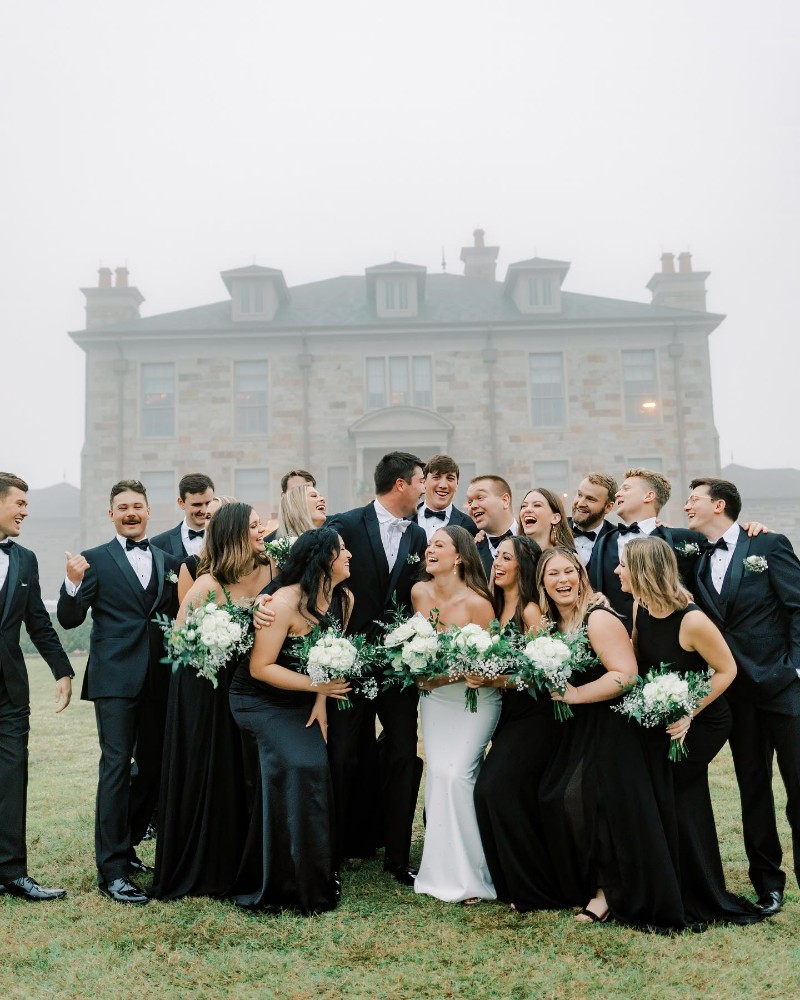
Photo by Emily Quigley Photography
How to Coordinate Multiple Officiants
When working with multiple officiants, assign clear roles for each person. One officiant typically leads the ceremony while others participate in specific elements like blessings or cultural traditions. Meet with all officiants together before the ceremony to discuss transitions and timing. Have them practice together during the rehearsal to ensure smooth handoffs.
How to Time Your Ceremony for Sunset Photos
Check your local sunset time and work backward. Plan to have your ceremony about 2-3 hours before sunset, allowing time for family photos afterward and couple portraits during golden hour (the hour before sunset). Consider having a "first look" earlier in the day to reduce the number of photos needed after the ceremony. Your photographer can help create a precise timeline based on your location and season.
How to Plan for Weather Contingencies
Your backup plan should be as detailed as your main plan. Book your indoor option early - don't wait until the last minute. Decide on a clear timeline for making the call to move indoors (usually 4-8 hours before). Have a plan for communicating changes to guests. Consider renting clear umbrellas or tents that match your style. Most importantly, remember that your ceremony will be special regardless of location.
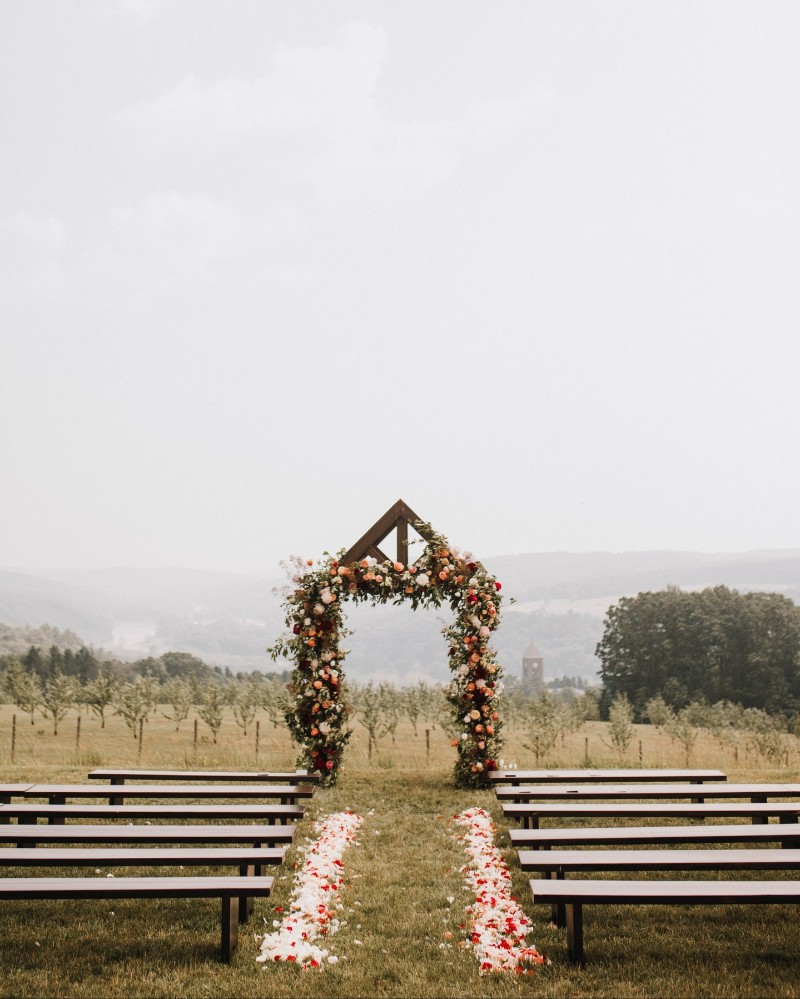
Photo by Jenny Callison Photography
How to Include Cultural Traditions in Your Ceremony
Start by identifying which traditions mean the most to both of you. You can shorten some traditional elements while keeping their essence. For example, if a traditional ceremony typically includes multiple readings, choose one or two most meaningful ones. Consider explaining key traditions in your ceremony program so guests understand their significance. Work with your officiant to weave traditions smoothly into your ceremony flow.
How to Create an Inclusive Ceremony
Consider your guests' needs when planning your ceremony. Provide seating with good sightlines for elderly guests, ensure wheelchair accessibility, and consider having a sign language interpreter if needed. Use gender-neutral language in your ceremony script and programs. If you're having readings or music, choose pieces that reflect your diverse community. Make sure all guests can hear by using a good sound system.
Do I Need an Order of Service?
It’s entirely up to you. Some folks like to print out orders of service or wedding programs so that the guests can expect some of the things in the ceremony.
If you’re planning an unconventional wedding, you can go ahead and design an order of service, but if it’s a conventional wedding, you could easily do without one. That said, wedding programs can be a beautiful touch to your day.
We’ve curated some wedding program examples here.
Bringing It All Together
Your wedding ceremony is a reflection of your unique love story, whether it's a traditional religious service, a cultural celebration, or an intimate gathering. While these ceremony orders provide helpful frameworks, remember that the most meaningful ceremonies are those that authentically represent you as a couple. Take what resonates from these guidelines and create a ceremony that tells your story in your own way.





